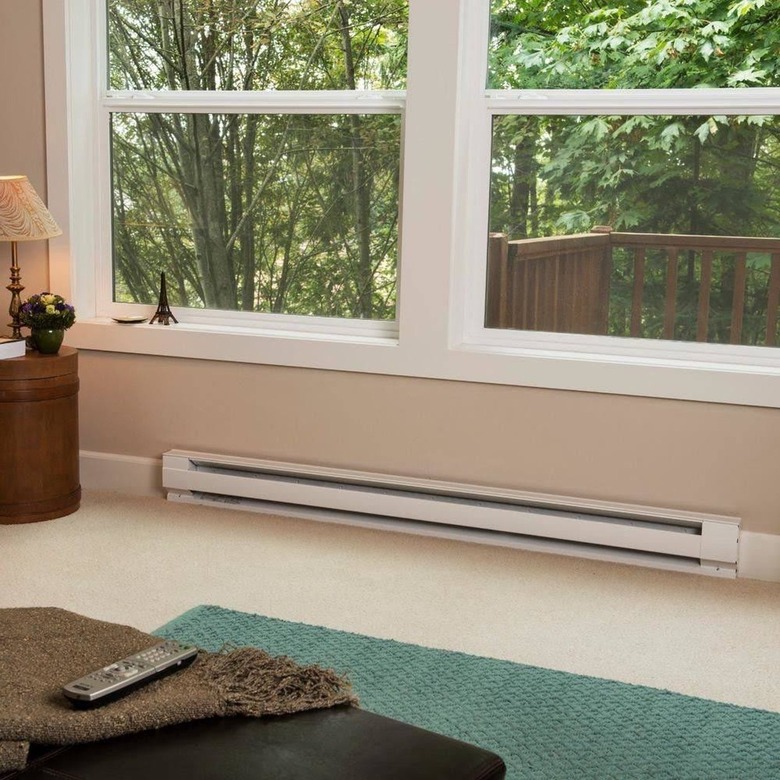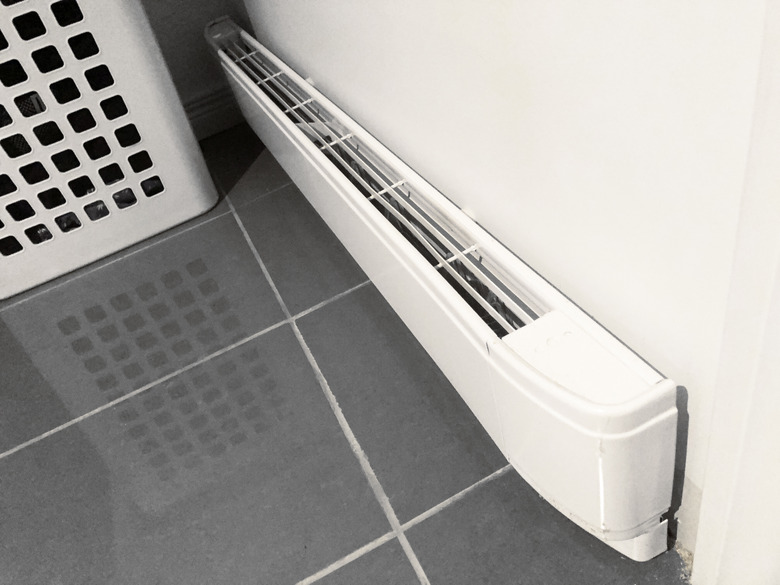A Homeowner's Guide To Electric Heating
We may receive a commission on purchases made from links.
Whether your old heating system broke down or you're simply looking to upgrade, you may be considering electric heating to keep your home warm and toasty in the winter. Electric heating generally has low installation costs, and installation is easy. Plus, it offers a quick and effective supplemental heating solution for poorly insulated buildings that are difficult to heat with central heating. You can simply plug in space heaters or baseboard heaters in rooms that need warmed up without disrupting your existing HVAC system. But like anything else, electric heating also has its drawbacks — namely, that it's expensive to run.
Many homeowners are drawn to the idea of electric heating because it's often thought of as a clean alternative to natural gas, propane, or heating oil for home heating — but this isn't actually the case. While it's true that a home with electric heaters generates no carbon emissions, the power plants that create the electricity do. And while many power companies are ramping up solar and wind production, the bulk of electricity on the grid still comes from fossil fuels. When you consider that power plants typically convert only 30 percent of fossil fuel energy into electricity (according to the U.S. Department of Energy) and that a significant amount of that electricity is lost by transmission lines, electric heating doesn't seem so clean after all.
However, electric heating has little effect on the air quality in the immediate environment inside and outside the home, and it's easy to maintain. Electric resistive heating — or heat produced by electrical resistance created by an electric current passing through a heating element — is highly adaptable and can be used for whole-house heating as well as for heating specific rooms. Depending on your situation, the benefits of electric heating may well outweigh the drawbacks.
How an Electric Heating System Works
How an Electric Heating System Works
The operation of an electric heater is simple: You connect the heater to a 120- or 240-volt electric circuit, and when you turn it on, electricity flows through the element and makes it glow red hot and radiate heat. The amount of heat is proportional to the current flowing through the heating element. Portable heaters generally have plugs for 120-volt receptacles, and heaters such as baseboard and radiant "cove" heaters can be hardwired to 120- or 240-volt circuits.
The more powerful electric heaters use 240 volts because it allows them to draw more amperage and get hotter without blowing a breaker. Each hardwired heater is typically controlled by its own thermostat, which may be built into the unit or mounted on the wall in the same room, and it directly controls the current flow and the heat output.
How Do I Know if I Have an Electric Heating System?
How Do I Know if I Have an Electric Heating System?
The glow of a heating element, even if it's inside an infrared heat bulb, is a sure sign of electric resistance heating, but you can't always see the heating element because it's hidden by a protective shield. If you aren't sure if your built-in heaters are electric (perhaps you live in a house with hydronic radiators and baseboard heaters, and you aren't sure if they are hydronic or electric), look for a thermostat. Each electric heater often has its own, and it's often mounted on the heater itself. Sometimes, however, there will be a wall-mounted one that controls all the heaters in a single room.
Hydronic heating systems, on the other hand, are typically controlled by a central thermostat that may be in a remote location (often near the boiler) and it controls all the heaters in a particular zone or in the whole house.
Permanently Installed Electric Heating Systems
Permanently Installed Electric Heating Systems
There are electric versions of several common types of heating systems, including furnaces, baseboard heaters, and wall heaters. In these cases, an electric element is used in place of gas, oil, or other heat source.
An electric furnace works exactly the same as a gas furnace, while being cleaner (generating no carbon monoxide), requiring less maintenance, and lasting 10 years longer on average. Electric models also are easier to install, and while they are always more expensive to operate than gas furnaces, they can be cost-effective in parts of the country where temperatures are moderate and electricity rates are comparatively low.
Electric baseboard heaters are more often used for heating individual rooms than entire houses, although they also be used throughout a house. A 240-volt, 1,500-watt unit costs about $70, and a homeowner with the necessary electrical skill can easily install one. In drafty rooms that are habitually cold, radiant cove heaters, which are like baseboard heaters mounted high on the wall near the ceiling, can supplement baseboard heat or can be used as a standalone heat source. Some models provide both radiant heat, which radiates outward from the heater, warming everything in its path, and convection heat, which wafts through the room on air currents. The combination is more comfortable than heated air from forced-air systems.
Electric Space Heaters
Electric Space Heaters
Another type of electric heater that you likely already know is the portable electric space heater. Space heaters can be plugged in anywhere needed and can be highly efficient heat sources, especially water-filled or oil-filled portable radiators. These are filled with water or oil, which are heated by resistive elements and continue to radiate heat after the elements switch off. They're also safer than units with exposed heating elements that can start fires if the units are placed too close to draperies or furniture or if they fall over.
Not All Electric Heat Is Resistive
Not All Electric Heat Is Resistive
A high-efficiency heat pump is also a type of electric heating system, and the electricity it consumes powers a compressor to circulate a refrigerant. The refrigerant then transfers heat from outdoor air, a body of water or the ground to warm the interior of a building. A central heat pump system costs about as much to install as a furnace, but homeowners can save money and skip the ductwork by opting for ductless systems that consist of several indoor units served by a single outdoor compressor. In terms of energy efficiency of home heating systems, electric or not, it's difficult to beat a ground-source, or geothermal, heat pump, but installation costs in existing homes are prohibitive for many homeowners.
The heating costs associated with a heat pump are about 50 percent lower than those for resistive heating, but heat pumps may not provide enough heat for houses in extreme climates. Resistive heaters are far less expensive to purchase and install and can provide effective supplemental heat in homes that already have heat from a central furnace or heat pump but not enough. Heating an entire house with resistive heat can be very expensive, but using resistive heaters sparingly in a home with an existing heat source as a way to take the chill out is far more economical and probably the best way to employ them.

